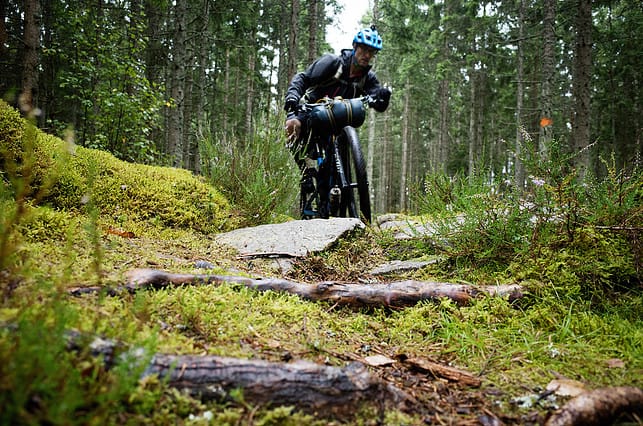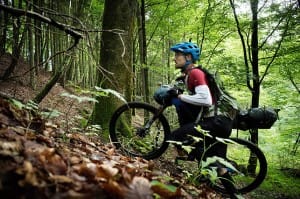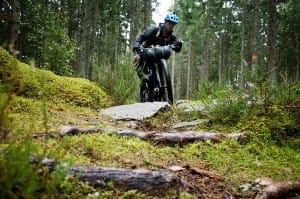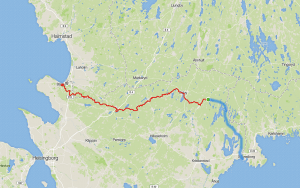af Jakob Carlsen
In my search for terrain a little similar to AZT I went to Sweden to ride Skaaneleden, a network of hiking trails connected by dirt roads. Like the AZT they are not designed for mountain biking. I got what I came for and, also learned a lesson or two.
I arrived in Solvesborg on the East coast Saturday at 12 am. The sky was grey and soon after it started to rain and it only rained harder as I hit the first trail, continuing to pour for the most of the day. The trails mainly pass through deep pine forests with lots of roots and rocks, all worn smooth by thousands of hikers passing through. When wet they get slippery, a challenge that is normally quite easy to tackle, by riding aggressively and constantly adjusting direction and weight distribution by the upper body and legs. But the extra weight on the bike, from carrying camping gear, caused instability and a loss of the ability to rapidly change direction made handling slow and sluggish.
First lesson learned; terrain that is technically demanding but predictable and easy to read is quite easy to tackle with the extra weight on the bike. On the contrary, when the terrain is unpredictable and demands constant attention and fast reactions, you get punished. Some sections was going straight up or downhill and had to be tackled on foot, pushing the bike.
Loosing it in the rain
In the days leading up to the trip I fell ill and felt tired, and I could still feel the discomfort in my body, a weakness and sluggishness pervading my body. After 30 kilometres I began feeling sore all over and my legs felt heavy and with no power. But I pushed on, helped by chia seed gel, tuna fish, peanut butter eaten right out of the can and a positive mindset. Lots of obstacles were scattered along the trail; toppled trees and wooden steps crossing animal fences. At one point my Garmin Oregon ran out of batteries and I had a short stop to insert fresh ones. I had a set that I knew was partly used, but I figured they would last for the rest of the day. But they ran out of power after an hour, and when looking in my frame bag for the small plastic bag holding fresh batteries it was gone. Looking at the unzipped bag I questioned if I had just unzipped it or if it had been unzipped since my last stop. My flashlight was gone too, and in a moment of fatigue and desperation, I figured that I might have lost them at my last stop to change batteries or along the trail, I had already covered. I backtracked searching the ground and vegetation along the trail but with no luck. With the twilight closing in and the rain pouring down I was desperate to find the batteries and first of all my flashlight. When I reached the point where I changed the batteries, I turned back around hiking the most overgrown sections searching the grass and vegetation along the trail. When I came back to the point where I backtracked from, I realized that the batteries and flashligt was lost for good and wondered if I should just pitch my tent and call it a day. I opened the bag with the can of peanutbutter to eat; and found both the batteries and the flashlight. In my fatigue and illness I had opened the wrong bag in the first place. Relieved, but chocked to realize that I had momentarily been so distracted, I continued my ride with fresh batteries in the gps and the flashlight on my helmet, repeating to myself that I have to be 100% aware of what I am doing at all times. A mistake like this could be fatal in the real wilderness.
At 10.30 pm I pitched my tent. With 80 kilometres on the clock I fell asleep with the motion of the bike slipping and sliding on wet roots and rocks, rolling through my body.
Next morning I woke up to the sound of cranes trumpeting. All my clothes was still soaking wet, so I quickly pulled it on with my down jacket and rainpants on top to get it warmer and dry-ish and hopefully a little less uncomfortable to wear. After a couple of powerbars and a cup of coffee I packed the bike and went. The rain had stopped during the night, the humidity still heavy in the air and soaking from the trees and vegetation. I soon realized that I felt a lot better than the day before. The terrain was less challenging, there were still sections with wet roots and rocks, but also long stretches with flowy and easier terrain. I got just as wet as the day before, but now from the overgrown trail. Pines, small deciduous trees, grass and other vegetation can hold a lot of water. Some sections disappeared in high grass, some of which hiding muddy water holes that I time after time found myself and the bike stuck in, both feet in the cold water halfway to my knees. But it was still fun and I soon forgot my cold feet and appreciated the warmth accumulated by my hard pedalling.
I arrived at the train station in Baastad 8.30 pm, purchased a ticket for me and the bike, jumped in my dry spare clothes with plastic bags over my feet to seperate them from the still soaking wet shoes. Then spend half an hour preparing a hot meal and a well deserved cup of coffee on the platform. With another 155 km on the clock, 235 km in two days, I was pretty tired and enjoyed relaxing in the train, snoozing, listening to an audiobook in my earphones.
My GPS track is shown below. The blue line represents the first day that was lost in my Garmin.



